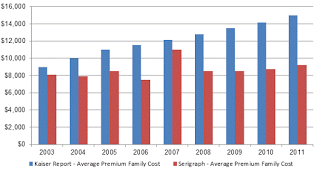“Helping employees improve their health is right for the company’s bottom line and is doing right by our employees. Healthier employees are happier, demonstrate less absenteeism and presenteesism, and are more productive. This is a win for everyone involved.” Quoted from John Torinus, Jr., in The Grassroots Healthcare Revolution; he is a retired CEO and current board chair of Serigraph, Inc“Helping employees improve their health is right for the company’s bottom line and is doing right by our employees. Healthier employees are happier, demonstrate less absenteeism and presenteesism, and are more productive. This is a win for everyone involved.” Quoted from John Torinus, Jr., in The Grassroots Healthcare Revolution; he is a retired CEO and current board chair of Serigraph, Inc., a mid-sized Wisconsin company with about 500 employees in the USA.
In my earlier posts in this series I have written primarily from the perspective of what primary care physicians can do to not only improve the health of their patients while reducing total costs of care yet also reclaim their right to practice in a non-frustrating environment with a limited number of patient visits per day. Torinus approaches improving health care from the perspective of a business leader faced with rising health care costs. Here I will quote and paraphrase from Torinus’ book and, since I basically agree with his recommendations, will amplify with some of my own thoughts.
He argues that company CEOs must make health care a strategic priority since it is one of the top three costs for any company. Healthcare costs can make the company noncompetitive if not managed aggressively. However, strategic priority to him also means it is essential for the company to attend in a proactive manner to the health and wellness of its employees, not just be the provider of an insurance plan.
CEOs need to think of the long term for their companies and therefore for their employees. The company and the employee together spend about $16,000 per year for a family for insurance today. An employee who works for a company for 25-40 years represents an insurance expenditure over a lifetime career that could be as much as $400,000 to $640,000 in today’s dollars. This drives home the point that it obviously only makes sense to have a long term view of employee health beginning with an aggressive approach to maintain wellness, actively reduce risk factors and manage disease as it occurs.
He observes that the current health care system focuses on specialty care whereas it needs to focus on the care recipient with high quality primary care – the patient/consumer/employee. But to be effective, the patient/consumer/employee needs to be engaged. The current healthcare system disengages the patient – it removes responsibility because the patient is not the customerof the doctor. In his company, expenses were rising to double digits by 2003 but with their new plan in place, it dropped to 2% or less per year.
Torinus’ “prescription” for all companies (and what his company initiated beginning in 2004) follows: First, every company, including small companies, should self-insure with an added stop-loss catastrophic policy. Second, employees should be offered only a consumer directed healthcare policy (CDHP), in essence a high deductible plan (often about $2500) with either an associated health savings account (HSA) or a health related account (HRA.) The company should prefund the account with an amount (often about $1500) that the individual can use for any health care needs with the assumption that since it is now the individual’s money, he or she will spend it more wisely – employee/patient engagement. Third, the company should insist that each provider have price transparency. Since that’s often difficult to obtain Serigraph uses various companies like Alithias Inc. to provide that for them so that they can compare one provider to another. For example, they determine the all-inclusive (gastroenterologist, anesthesiologist and facility fee) price along with quality data of colonoscopies at the nearest five centers and then rank them. The employee or family member who needs the colonoscopy is told that, for example, the company sees it as appropriate preventive care and so will cover the cost, in this case up to $1,500. [His book appeared before the ACA became law so colonoscopy would be covered now by the insurance component but the principle is still valid.] This is an amount that will pay for say, four of the five local centers; but if he or she selects a provider that charges more, they are on the hook for the remainder. Fourth, if the company is large enough, it should provide an on-site primary care clinic at no cost to the individual. At Serigraph, the clinic includes a concierge-type physician (meaning that the physician is salaried, has a low number of patients under care and gives extensive time and energy to each employee/family member patient consistent with some of my previous posts) plus a nurse practitioner, a health coach, a dietician, and a chiropractor. If the company is too small to justify a full-fledged clinic then the company can pay the retainer for a nearby direct primary care/membership/concierge physician who works with others such as the health coach. Fifth, the clinic, with special attention by the health coach, gives all employees a health risk assessment annually and then works one-on-one with each employee (and family member) at no cost to maintain wellness and health including the use of behavioral change programs around diet, nutrition, exercise, stress management and smoking cessation. Sixth, there is very intense management of chronic diseases by the clinic staff and coordination of specialist visits when needed. Seventh, Serigraph uses what Torinus calls Centers of Value for procedures beyond those that are done by the primary care physician. These are doctors/institutions that have outstanding quality records yet a competitive price for, say, a knee replacement. Serigraph gives their employees $2,000 toward the deductible or totally covers the deductible for the surgery when they make use of these Centers of Value. Seventh, his company gives (and he recommends others do likewise) generic drugs for free and all of the above prevention and wellness programs are supplied free of charge. Finally, the company makes free counseling available for developing advanced directives and in the event that an individual requires end of life care, hospice is available free of charge.
I notice that his company spends considerably on extensive/comprehensive primary care including wellness maintenance, proactive prevention and chronic care management but it is rewarded in return with lower total costs and healthier workers.
Given that healthcare has become a company strategic priority, then it needs to be managed and that requires data. Hence, he urges all companies to develop health-related management dashboards including both a financial dashboard (how much is the company spending) and a health dashboard (how many individuals in the company have uncontrolled blood pressure, uncontrolled asthma, uncontrolled cholesterol, have not had appropriate mammography or colonoscopy, etc. – all information collected from the clinic in an unidentified manner to protect individual privacy).
These approaches are based on fundamental principles including individual responsibility; market place discipline – installing consumerism, steering business to the best quality and price (“do good work and you get our business”); proactive care – maintain employees’ health and wellness and give extensive care to those with chronic illnesses; and sound management – putting those who pay, i.e., the employer and the employee, in charge.
Torinus suggests there are multiple rewards for following this basic approach (I added number 2 since he implied but did not write it.)
1) The reward for business is a healthier work force and more affordable healthcare expenditures.
2) The reward for individuals is more health and wellness, less illness and fewer dollars spent.
3) The reward for high value providers is more business.
4) The reward for entrepreneurs comes if they innovate with better care provided at lower cost
5) There could be a reward for tax payers – if government (federal, state and local) were to utilize these approaches
Sound advice. Your thoughts?
The next post will delve into company wellness programs.










